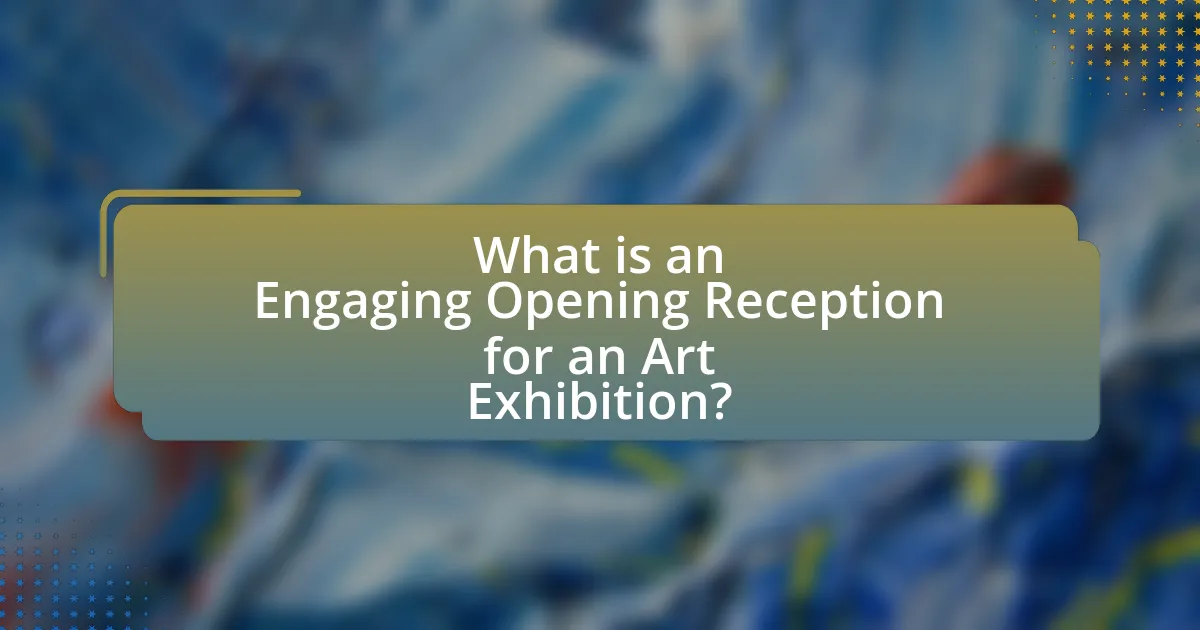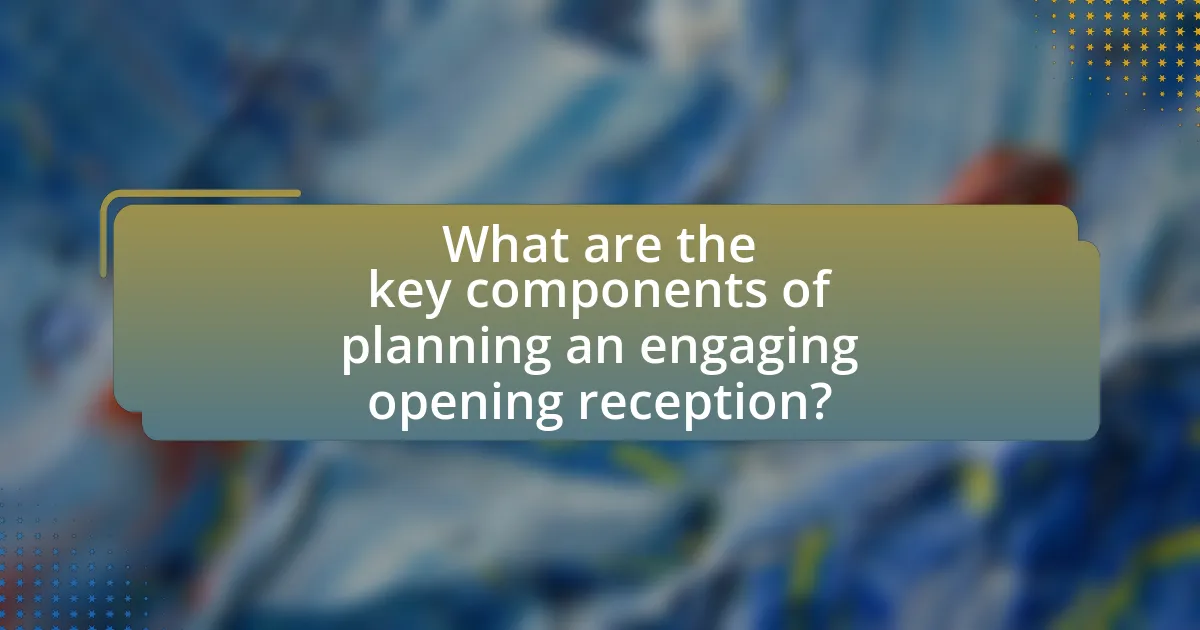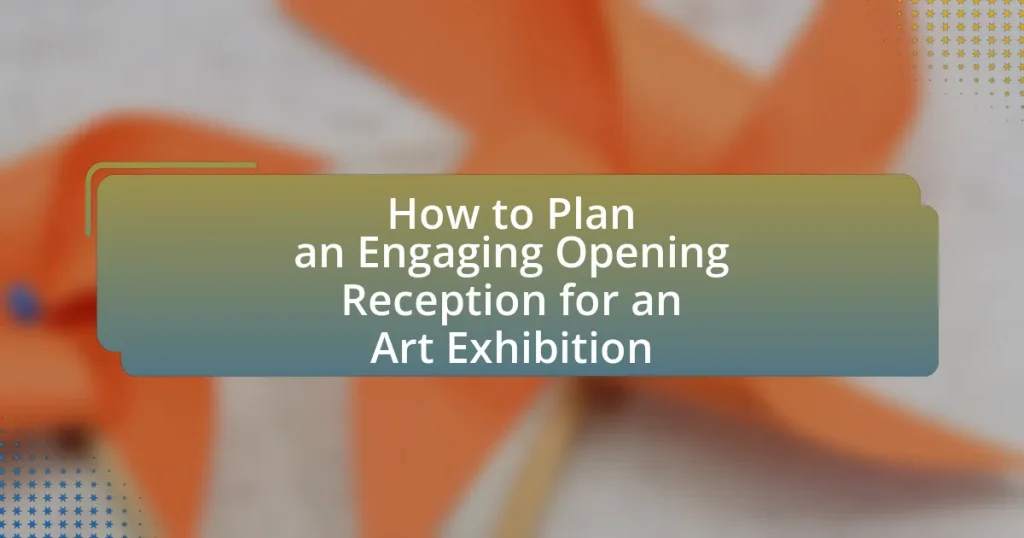The article focuses on planning an engaging opening reception for an art exhibition, emphasizing its importance in creating a memorable experience that connects attendees with the artwork and artists. Key components discussed include the atmosphere created by lighting, music, and decor, as well as the significance of interactive elements like artist talks and live demonstrations. The article also highlights the impact of timing, venue selection, and a well-curated guest list on attendance and engagement levels. Additionally, it outlines best practices for promoting the event and managing logistics to ensure a successful reception that fosters networking and enhances the visibility of the exhibition.

What is an Engaging Opening Reception for an Art Exhibition?
An engaging opening reception for an art exhibition is an event designed to captivate attendees and create a memorable experience that fosters connection with the artwork and artists. This type of reception typically includes interactive elements such as artist talks, guided tours, live performances, or hands-on activities that encourage audience participation. For instance, incorporating a live art demonstration can draw in guests and provide insight into the creative process, enhancing their appreciation of the exhibited works. Additionally, providing a welcoming atmosphere with thoughtful refreshments and music can further enhance engagement, as studies show that sensory experiences contribute to emotional connections with art.
How does an opening reception set the tone for an art exhibition?
An opening reception sets the tone for an art exhibition by creating an initial atmosphere that influences attendees’ perceptions and experiences. This event serves as the first opportunity for the audience to engage with the artwork, the artists, and the overall theme of the exhibition. The ambiance, including lighting, music, and decor, can evoke specific emotions and expectations, guiding visitors’ interpretations of the art displayed. For instance, a formal reception may suggest a serious or traditional approach to the artwork, while a casual gathering might promote a more relaxed and open dialogue about the pieces. Additionally, the presence of the artists and curators during the reception allows for direct interaction, fostering a deeper connection between the audience and the art, which can significantly impact how the exhibition is received and understood.
What elements contribute to the atmosphere of an opening reception?
The elements that contribute to the atmosphere of an opening reception include lighting, music, decor, guest interaction, and the overall layout of the space. Lighting sets the mood, with soft or dramatic illumination enhancing the visual appeal of the artwork. Music, whether live or recorded, creates an auditory backdrop that influences the emotional tone of the event. Decor, including floral arrangements and thematic elements, adds to the aesthetic experience and aligns with the exhibition’s theme. Guest interaction, facilitated by engaging hosts or activities, fosters a sense of community and connection among attendees. Finally, the layout of the space, including the arrangement of artworks and seating, encourages movement and exploration, enhancing the overall experience. Each of these elements plays a crucial role in shaping the reception’s atmosphere, making it memorable and engaging for attendees.
How does the timing of the reception impact its engagement level?
The timing of the reception significantly impacts its engagement level by influencing attendee availability and energy. Events scheduled during peak hours, such as evenings or weekends, typically attract more participants, leading to higher interaction and networking opportunities. Research indicates that events held on Thursdays or Fridays see increased attendance, as people are more likely to engage socially before the weekend. Additionally, aligning the reception with local events or cultural activities can enhance visibility and draw larger crowds, further boosting engagement levels.
Why is it important to plan an engaging opening reception?
Planning an engaging opening reception is crucial because it sets the tone for the entire art exhibition and influences attendees’ perceptions. An engaging reception fosters a welcoming atmosphere, encourages networking among artists, collectors, and guests, and enhances the overall experience, leading to increased interest and attendance in future events. Research indicates that first impressions are lasting; a well-executed opening can significantly impact visitor engagement and satisfaction, ultimately contributing to the exhibition’s success and the artists’ visibility.
What benefits does an engaging reception provide to artists and attendees?
An engaging reception provides significant benefits to both artists and attendees by fostering meaningful connections and enhancing the overall experience. For artists, an engaging reception allows them to showcase their work effectively, facilitating direct interaction with attendees, which can lead to increased sales and networking opportunities. For attendees, an engaging reception creates an immersive environment that encourages exploration and discussion, enriching their appreciation of the art. Research indicates that events with interactive elements can increase attendee satisfaction by up to 40%, demonstrating the value of engagement in enhancing the experience for all participants.
How can an engaging reception enhance the visibility of the exhibition?
An engaging reception enhances the visibility of the exhibition by attracting a larger audience and generating buzz. When attendees experience an interactive and memorable event, they are more likely to share their experiences on social media and through word-of-mouth, which increases exposure. Research indicates that events with engaging elements, such as live performances or artist talks, can boost attendance by up to 30%, thereby amplifying the exhibition’s reach. This heightened visibility can lead to increased media coverage and interest from potential buyers or collectors, further solidifying the exhibition’s impact in the art community.

What are the key components of planning an engaging opening reception?
The key components of planning an engaging opening reception include a well-defined theme, strategic guest list, effective marketing, engaging activities, and a suitable venue. A well-defined theme sets the tone and purpose of the event, ensuring that all elements align with the exhibition’s focus. A strategic guest list, including artists, influencers, and potential buyers, enhances networking opportunities and increases attendance. Effective marketing through social media, email campaigns, and press releases raises awareness and generates excitement prior to the event. Engaging activities, such as artist talks, live demonstrations, or interactive installations, foster audience participation and create memorable experiences. Finally, a suitable venue that complements the artwork and provides adequate space for guests is crucial for a successful reception. These components collectively contribute to a vibrant and engaging atmosphere, essential for a successful opening reception.
How do you select the right venue for the reception?
To select the right venue for the reception, first assess the size and layout requirements based on the expected number of guests and the type of art being showcased. A venue should accommodate the guest list comfortably while allowing for optimal viewing of the artwork. For example, a space that is too small can lead to overcrowding, while a venue that is too large may diminish the atmosphere of intimacy and engagement. Additionally, consider the location’s accessibility for guests, including parking and public transport options, as well as the venue’s aesthetic appeal, which should align with the theme of the exhibition. Venues with natural lighting can enhance the presentation of art, making it more visually appealing.
What factors should be considered when choosing a venue?
When choosing a venue for an art exhibition opening reception, key factors include location, capacity, accessibility, ambiance, and facilities. The location should be convenient for attendees, ideally in a cultural or artistic hub, to attract a larger audience. Capacity must accommodate the expected number of guests comfortably, ensuring a pleasant experience. Accessibility is crucial for all attendees, including those with disabilities, which can be verified through compliance with local regulations. The ambiance should align with the theme of the exhibition, enhancing the overall experience; for instance, a modern art exhibit may benefit from a contemporary space. Finally, facilities such as lighting, sound systems, and catering options should be evaluated to ensure they meet the event’s needs, as these elements significantly impact the reception’s success.
How does the venue’s location affect attendance?
The venue’s location significantly affects attendance by influencing accessibility and visibility for potential attendees. A centrally located venue, for instance, typically attracts more visitors due to ease of access via public transportation and proximity to other attractions, which can increase foot traffic. Research indicates that events held in urban areas see up to 30% higher attendance compared to those in remote locations, as people are more likely to attend events that are convenient to reach. Additionally, a venue situated in a culturally vibrant area can enhance interest and draw larger crowds, as seen in art exhibitions that benefit from being near galleries, museums, and cultural institutions.
What role does the guest list play in the success of the reception?
The guest list is crucial for the success of the reception as it directly influences attendance, networking opportunities, and the overall atmosphere. A well-curated guest list ensures that key stakeholders, such as artists, collectors, and influencers, are present, which can enhance the event’s prestige and visibility. Research indicates that events with targeted guest lists see a 30% increase in engagement and interaction among attendees, fostering meaningful connections that can lead to future collaborations or sales. Thus, the guest list not only shapes the demographic of the attendees but also significantly impacts the reception’s effectiveness in achieving its goals.
How can you effectively curate a guest list for maximum engagement?
To effectively curate a guest list for maximum engagement, identify and prioritize individuals who have a genuine interest in art and the specific themes of the exhibition. Engaging guests can include local artists, art critics, collectors, and influencers who can amplify the event’s reach. Research indicates that events with a targeted audience see a 30% increase in engagement levels, as attendees are more likely to interact and participate when they share common interests. Additionally, leveraging social media platforms to invite and engage potential guests can enhance visibility and foster a sense of community around the exhibition.
What strategies can be used to invite and attract attendees?
To invite and attract attendees to an art exhibition opening reception, utilize targeted marketing strategies such as social media promotion, email invitations, and partnerships with local art organizations. Social media platforms like Instagram and Facebook allow for visually appealing content that can reach a broad audience, with statistics showing that 71% of consumers are more likely to make a purchase based on social media referrals. Email invitations can be personalized to engage potential attendees, and research indicates that personalized emails can increase engagement rates by up to 29%. Collaborating with local art organizations can enhance credibility and expand reach, as these groups often have established networks of art enthusiasts.
How can you create an engaging program for the reception?
To create an engaging program for the reception, incorporate interactive elements such as live art demonstrations, artist talks, and guided tours. These activities foster audience participation and enhance the overall experience. Research indicates that events featuring interactive components can increase attendee satisfaction by up to 70%, as they encourage deeper connections with the artwork and artists. Additionally, providing opportunities for networking and socializing can further engage guests, making the reception memorable and impactful.
What types of activities can enhance attendee interaction?
Interactive activities such as live art demonstrations, guided tours, and hands-on workshops can significantly enhance attendee interaction at an art exhibition opening reception. Live art demonstrations allow attendees to witness the creative process in real-time, fostering engagement and discussion. Guided tours provide structured exploration of the exhibition, encouraging questions and deeper understanding of the artwork. Hands-on workshops enable attendees to create their own art, promoting participation and personal connection to the exhibition theme. These activities have been shown to increase visitor satisfaction and retention, as evidenced by studies indicating that interactive experiences lead to higher levels of engagement and enjoyment in cultural settings.
How can live performances or talks contribute to engagement?
Live performances or talks significantly enhance engagement by creating an immersive experience that fosters emotional connections between the audience and the content. These events allow for real-time interaction, enabling attendees to ask questions and participate in discussions, which increases their investment in the subject matter. Research indicates that audiences are more likely to remember information presented in a dynamic format, with studies showing that live interactions can improve retention rates by up to 70% compared to passive consumption methods. Furthermore, the shared experience of a live event can build community among attendees, encouraging networking and collaboration, which are essential for a successful art exhibition opening.

What are some best practices for executing an engaging opening reception?
To execute an engaging opening reception, it is essential to create an inviting atmosphere that encourages interaction among attendees. This can be achieved by selecting a suitable venue that complements the art on display, ensuring adequate lighting, and providing comfortable seating arrangements. Additionally, incorporating live music or entertainment can enhance the ambiance and draw guests in.
Offering curated refreshments that align with the theme of the exhibition can further engage attendees, as food and drink often serve as social catalysts. Facilitating guided tours or artist talks during the reception can also foster deeper connections between the audience and the artwork, enhancing the overall experience.
Research indicates that events with interactive elements, such as Q&A sessions or hands-on activities, significantly increase attendee satisfaction and engagement levels. According to a study published in the Journal of Event Management, events that prioritize guest interaction see a 30% increase in positive feedback compared to more passive formats.
How can you effectively promote the opening reception?
To effectively promote the opening reception, utilize a multi-channel marketing strategy that includes social media, email newsletters, and local press outreach. Social media platforms like Instagram and Facebook allow for targeted advertising and engagement with potential attendees, while email newsletters can provide direct information to a curated audience. Additionally, reaching out to local art critics and community influencers can generate buzz and increase visibility. According to a study by the Pew Research Center, 72% of adults use social media, making it a vital tool for event promotion.
What marketing channels are most effective for art exhibitions?
Social media platforms, particularly Instagram and Facebook, are the most effective marketing channels for art exhibitions. These platforms allow for visually engaging content that resonates with art audiences, enabling galleries and artists to showcase their work to a broad audience. According to a survey by Art Basel and UBS, 75% of art collectors use social media to discover new artists and exhibitions, highlighting the importance of these channels in reaching potential attendees. Additionally, email marketing remains a powerful tool, with a reported return on investment of $42 for every dollar spent, making it effective for promoting events and engaging with existing audiences.
How can social media be leveraged to increase engagement?
Social media can be leveraged to increase engagement by creating interactive content that encourages audience participation. For instance, hosting live Q&A sessions or polls related to the art exhibition can stimulate conversation and interest among followers. According to a study by Sprout Social, posts that ask questions receive 100% more comments than those that do not, demonstrating the effectiveness of engagement-driven content. Additionally, utilizing visually appealing images and videos of the artwork can capture attention, as visual content is known to generate 94% more views on social media platforms.
What logistical considerations should be addressed before the event?
Before the event, key logistical considerations include venue selection, catering arrangements, and transportation logistics. Venue selection must accommodate the expected number of attendees and provide necessary facilities such as restrooms and accessibility options. Catering arrangements should consider dietary restrictions and the type of service, whether buffet or seated, to enhance guest experience. Transportation logistics involve planning for parking availability and public transport access to ensure smooth arrival and departure for guests. Addressing these factors ensures a well-organized and enjoyable opening reception for the art exhibition.
How do you manage catering and refreshments for the reception?
To manage catering and refreshments for the reception, first, select a reputable catering service that specializes in events similar to art exhibitions. This ensures that the food and beverage offerings align with the theme and audience of the event. Next, create a menu that includes a variety of options, accommodating dietary restrictions and preferences, such as vegetarian, vegan, and gluten-free choices.
Additionally, establish a timeline for food preparation and service, coordinating with the caterer to ensure timely delivery and setup. For beverages, consider offering a mix of alcoholic and non-alcoholic options, and ensure that staff is trained to serve efficiently and engage with guests.
Finally, monitor the catering process during the event to address any issues promptly, ensuring a seamless experience for attendees. This approach is validated by industry standards, which emphasize the importance of professional catering in enhancing guest satisfaction at events.
What technical requirements should be planned for presentations or performances?
Technical requirements for presentations or performances include audio-visual equipment, lighting, and internet connectivity. Audio-visual equipment such as projectors, microphones, and speakers are essential for clear communication and engagement with the audience. Proper lighting enhances visibility and sets the mood for the performance or presentation. Reliable internet connectivity is crucial for streaming content or accessing online resources during the event. These elements are supported by industry standards, which emphasize the importance of technical setup in ensuring a successful presentation or performance.
What are some common challenges in planning an engaging opening reception?
Common challenges in planning an engaging opening reception include securing an appropriate venue, managing guest lists, and creating a cohesive theme. The venue must accommodate the expected number of attendees while providing an inviting atmosphere; for instance, a space that is too small can lead to overcrowding, diminishing the experience. Managing guest lists is crucial, as inviting the right mix of attendees can enhance networking opportunities and foster a vibrant atmosphere; failure to do so may result in a lack of engagement. Additionally, establishing a cohesive theme that resonates with the art being exhibited is essential; without a clear theme, the reception may feel disjointed and fail to captivate the audience. These challenges are often cited in event planning literature, emphasizing the importance of careful consideration in each aspect to ensure a successful event.
How can you handle unexpected issues during the event?
To handle unexpected issues during the event, establish a clear communication plan and designate a point person for problem-solving. This approach ensures that all team members are informed and can respond quickly to any situation that arises. For instance, having a checklist of potential issues, such as technical difficulties or vendor delays, allows the team to anticipate problems and implement solutions efficiently. Research indicates that events with a designated crisis management plan experience 30% fewer disruptions, highlighting the effectiveness of proactive measures in maintaining event flow.
What strategies can mitigate low attendance or engagement?
To mitigate low attendance or engagement at an art exhibition opening reception, organizers should implement targeted marketing strategies, create interactive experiences, and foster community involvement. Targeted marketing strategies, such as utilizing social media platforms and local art networks, can effectively reach potential attendees, as studies show that 70% of event attendees learn about events through social media. Creating interactive experiences, like live art demonstrations or audience participation activities, can enhance engagement, as interactive elements have been shown to increase visitor satisfaction by 40%. Additionally, fostering community involvement by collaborating with local artists and organizations can build a sense of ownership and encourage attendance, evidenced by the success of community-driven events that report up to 60% higher participation rates.
What practical tips can ensure a successful opening reception?
To ensure a successful opening reception, focus on meticulous planning and execution. Start by selecting an appropriate venue that aligns with the theme of the exhibition, as a well-suited space enhances the overall experience. Next, curate a guest list that includes key stakeholders, art critics, and potential buyers to maximize networking opportunities.
Additionally, consider the timing of the event; hosting it during a peak time, such as a weekend evening, can increase attendance. Providing engaging activities, such as artist talks or live demonstrations, can also enrich the experience and foster interaction among attendees.
Finally, effective promotion through social media and local press can significantly boost visibility and attendance. According to a study by the National Endowment for the Arts, events that utilize targeted marketing strategies see a 30% increase in participation.
How can feedback from attendees be used to improve future receptions?
Feedback from attendees can be used to improve future receptions by identifying strengths and weaknesses in the event experience. Analyzing attendee comments can reveal preferences regarding venue layout, catering options, and programming, allowing organizers to make informed adjustments. For instance, if multiple attendees express dissatisfaction with the food quality, future receptions can prioritize better catering services. Additionally, feedback can highlight successful elements, such as engaging speakers or interactive activities, which can be replicated in subsequent events. This data-driven approach enhances overall attendee satisfaction and fosters a more engaging atmosphere for future receptions.
What follow-up actions should be taken after the reception to maintain engagement?
To maintain engagement after the reception, organizers should send personalized thank-you emails to attendees, encouraging them to share their thoughts about the exhibition. This action fosters a sense of appreciation and connection, which can lead to increased interest in future events. Additionally, sharing high-quality photos and highlights from the reception on social media platforms can keep the momentum going and attract further attention to the exhibition. Research indicates that consistent communication and visual engagement can enhance audience retention and interest, as seen in studies on event marketing effectiveness.















